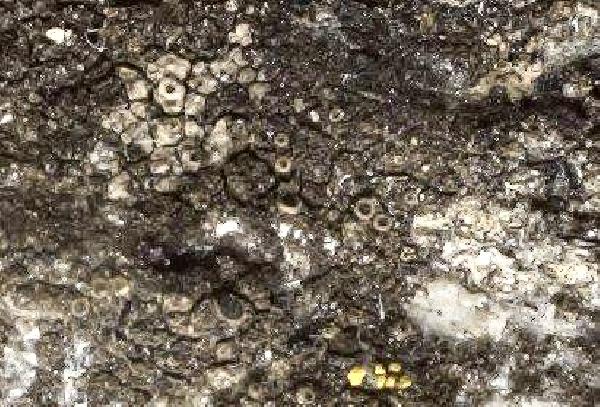Rinodina furfurea H. Mayrhofer & Poelt
Bibl. Lichenol., 12: 177, 1979.
Synonyms:
Distribution: N - TAA. S- Si (Nimis & al. 1996b).
Description: Thallus crustose, episubstratic, medium brown, rimose-areolate, not well-delimited, without a distinct prothallus, the areoles 0.2-0.5(-1) mm wide, flat, constricted at base, soon giving rise to granulose to subcylindrical, black-brown, almost isidioid soredia which may cover the whole upper surface. Apothecia lecanorine, 0.2-0.4 mm across, with a persistently flat, black-brown disc, and a rather thick, smooth, persistent thalline margin. Epithecium brown, K-; hymenium colourless, 60-80 µm high; paraphyses simple or sparingly branched in upper part, 1.5-2.5 µm thick at mid-level, the apical cells 4-5 µm wide; hypothecium colourless, up to 100 µm high. Asci 8-spored, clavate, the K/I+ blue tholus penetrated by a faintly amyloid apical cushion with parallel or diverging flanks, the wall K/I-, surrounded by a K/I+ blue outer layer, Lecanora-type. Ascospores 1-septate, brown, ellipsoid, 10-16 x 7-9 µm, Dubyana-type. Photobiont chlorococcoid. Spot tests: K-, C-, KC-, P-, UV-. Chemistry: without lichen substances.Note: known only from a few collections, on exposed siliceous rocks in very dry sites, this interesting species needs further study.
Growth form: Crustose
Substrata: rocks
Photobiont: green algae other than Trentepohlia
Reproductive strategy: mainly asexual, by isidia, or isidia-like structures (e.g. schizidia)
Commonnes-rarity: (info)
Alpine belt: absent
Subalpine belt: absent
Oromediterranean belt: absent
Montane belt: very rare
Submediterranean belt: absent
Padanian area: absent
Humid submediterranean belt: absent
Humid mediterranean belt: absent
Dry mediterranean belt: absent

Predictive model
Growth form: Crustose
Substrata: rocks
Photobiont: green algae other than Trentepohlia
Reproductive strategy: mainly asexual, by isidia, or isidia-like structures (e.g. schizidia)
Commonnes-rarity: (info)
Alpine belt: absent
Subalpine belt: absent
Oromediterranean belt: absent
Montane belt: very rare
Submediterranean belt: absent
Padanian area: absent
Humid submediterranean belt: absent
Humid mediterranean belt: absent
Dry mediterranean belt: absent

Predictive model
 INDEX FUNGORUM
INDEX FUNGORUM
 GBIF
GBIF
 DOLICHENS
DOLICHENS


